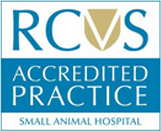Periodontal disease
Periodontal disease (or gum disease) is a bacterial infection of the mouth that causes weakening and eventual loss of the supporting structures of the teeth.
Periodontal diseas can cause significant harm to a cat’s mouth, eventually leading to chronic pain and tooth loss. It can also increase the risk of heart, liver and kidney disease. There are often no obvious signs in the early stages of gum disease, so by the times symptoms are noticed, your pet may already have advanced disease. Symptoms are often noticed in older cats with advanced periodontal disease, but it is important to know that over 60 of dogs have early stages of gum disease by the age of three.
Feline resorptive lesions
Feline resorptive lesions affect more than one third of adult cats. The precise cause of these lesions is unknown. Second to periodontal disease, resorptive leions are the most common oral problem seen in cats. Resorption leads to damage of the tooth crown and root and is a painful condition.
Fractured teeth
Fractured teeth are common. The canine teeth (fangs) of cats often have fractures of the tip of the tooth. Since the pulp chamber extends very close to the tip of the tooth in cats, even small fractures can expose sensitive pulp tissue. A fractured tooth can be very painful and will usually lead to infection and death of the pulp tissue.
Feline chronic gingivostomatitis
Feline chronic gingivostomatits is severe inflammation or ulceration of the oral tissue and is a debilitating disease for affected cats. This condition usually requires aggressive treatment. Juvenile gingivitis is a severe gingivitis that can develop following tooth eruption. Cats will often have notable halitosis. Left untreated, this may progress to periodontal disease.
Frequently Asked Questions
What are the signs my cat may have dental disease?
- Bad breath
- Loose teeth or teeth that are discoloured or covered in tartar/calculus
- Broken or missing teeth
- Your pet shies away from you when you touch the mouth area
- Drooling or dropping food from the mouth
- Bleeding from the mouth
- Loss of appetite or weight loss (this combination can result from disease of many organs and early veterinary examination is important)
Is dental disease painful for my cat?
Yes, it very often is.
Have a good look at your cat’s mouth and try to imagine how your mouth would feel if it looked the same!
Most pets with painful dental conditions do not show clinical signs that are obvious to the owner, but this does not mean that they are not feeling pain. They cannot tell you about the pain. In the wild, animals tend to hide signs of illness or weakness and dogs and cats possess this instinct.
Many painful dental conditions develop gradually and are more common in middle aged and older pets. As a result, behaviour that the owner interprets as “acting grumpy” may be the result of dental pain. Owners often observe that their pet acts “years younger” following dental treatment so make sure that your vet and cat dentist examines your cat’s mouth every time your pet visits the veterinary surgery.
How does the vet assess and treat dental disease in cats?
Physical examination during a consultation.
- Full oral examination from your cat dentist under general anaesthetic with Dental X Rays as up to 60% of dental disease is under the level of the gum.
- A prossional dental cleaning to reduce bacteria and help guard against periodontal disease.
- Treatment of the diseased teeth or extractions as necessary.
Can I provide pet dental care at home?
Below are listed some common forms of oral hygiene that are of benefit for cats. Combining several methods will achieve the best results.
All methods of home oral hygiene share the goal of preventing or controlling periodontal disease by minimising plaque accumulation.
Cats can be very reluctant to accept home pet dental care and require a very gradual, gentle and patient approach to achieve success.
Try several options to find those techniques and products that your cat best tolerates:
- Brush teeth on a daily basis to help reduce plaque, a sticky film that contains the bacteria that cause periodontal disease. Be sure to use toothpaste that is recommended for cats. For tips on how to brush your cat’s teeth why not watch our video?
- Several dental specific diets have been shown to be of benefit in retarding the accumulation of dental plaque and tartar in cats
- Visit your veterinarian for regular professional dental cleanings and pet dental care.
Dental diets do not take the place of brushing but is a great supplement to oral hygiene and a treat for your pet.














